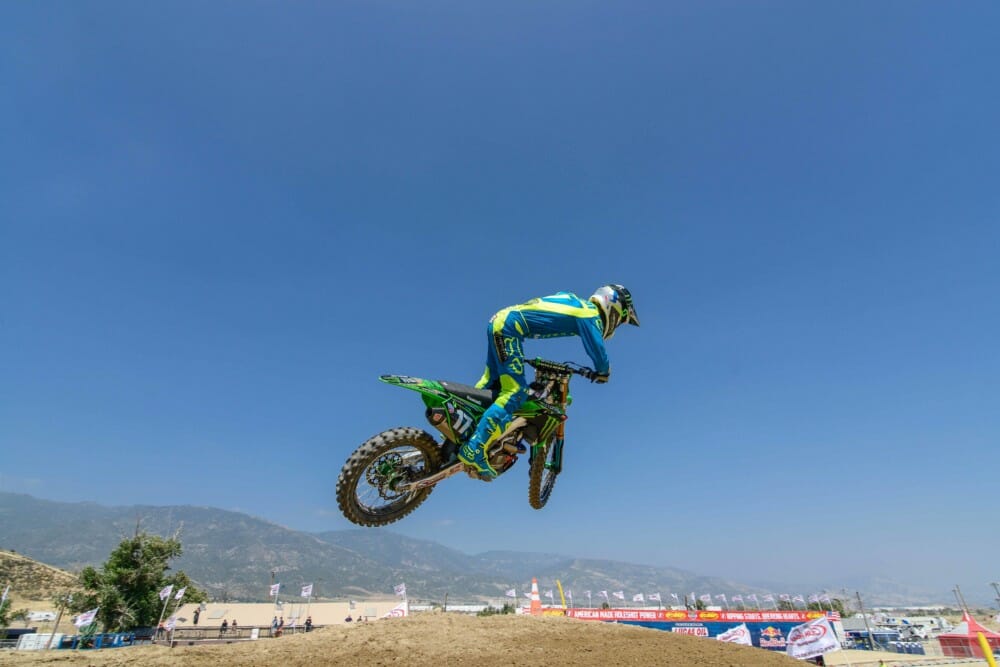Steve Cox | July 24, 2019
Cycle News Empire of Dirt
COLUMN
Better Bikes Equal Tougher Sport?
I love the sport of motocross and supercross. It’s been my life’s primary obsession ever since my parents bought me my first motorcycle when I was 10 (and I was fairly obsessed with the sport even prior to that, spending hours staring at photos on the wall of my dad jumping his 1971 Husqvarna 400). I’m 42 now.
I grew up racing in the late 1980s and early-mid 1990s. In that era, especially in Southern California, supercross had already begun to dominate the racing landscape. Nearly every track in SoCal featured big, man-made tabletops, doubles, triples, and often even stadium whoops. When I hear people nowadays talk about how tracks are dangerous, all I can do is shake my head and think back to the early-mid 1990s at Perris, California’s Starwest Supercross Park. Those jumps were massive, and often the landings were almost as steep as the takeoffs. Back then, when I was about 14 years old, there was one particular hybrid-table/double in the middle of the track for a long time that was out of a 180-degree left-hand turn, with a launch probably 15 feet high (blind) and 50 feet or so in distance, and we were using the inside line on 125cc two-strokes, in first gear, and grabbing second at the base of the takeoff just praying we stayed “on the pipe” because the landing was just as steep. The good news was that if you greased it, it was like landing on a cloud. The bad news was that if you were just a few feet long or short, the paramedics might end up having to scrape you off the blue-grooved dirt with a shovel.
 Four-strokes certainly changed the way we ride motocross.
Four-strokes certainly changed the way we ride motocross.
Tracks today aren’t dangerous at all when judged against the tracks of a quarter-century ago. But here’s the thing: Before I could even think about jumping things like that hybrid-table/double, I already had to know how to corner, shift, use my clutch, use throttle control for traction, and keep the bike in the powerband. I also had to have good body position, know how to use the throttle and rear brake in the air to adjust the motorcycle’s attitude, and my motorcycle had to be set up (at least close to) correctly.
The perception of danger today is primarily rooted in how easy it is to ride modern four-strokes, and how little skill is actually necessary before people feel like they can jump things they really shouldn’t be trying to jump. This is especially true of 450s, although it applies to 250s as well.
I can imagine being on a new four-stroke on that Starwest track in 1991-1992 and being confronted with that hybrid-table/double, and it would’ve been a far less daunting proposition. I wouldn’t have had to be good at cornering, because if I messed up the turn, the bike has plenty of power to get me back up to speed before the launch. Shifting wouldn’t really matter, either, as long as I was in second gear (on a 250) in the previous turn. I’d only need to know how to use a clutch well enough to keep from stalling. Throttle control would be far less necessary because of how four-strokes deliver power, and now that electronic traction-control has entered the game, throttle control would be almost entirely unnecessary. And what’s a powerband? Four-strokes have power everywhere. And when it came to using controls in the air to adjust the motorcycle’s attitude, or my body position, or bike setup? You don’t know what you don’t know, right? So, basically, that list of skills I had to acquire in the early 1990s would’ve been shortened to:
Step 1: Turn the throttle.
Step 2: Hold on.
But all of those bike skills we had to have in the 1990s served another, perhaps more important, purpose: They helped us more effectively deal with situations when things went wrong. We were much better-prepared for situations like over-jumping or casing an obstacle, or if we got sideways unexpectedly, or any other number of circumstances that weren’t ideal. And those “post-jump-attempt” skills probably kept the sport seeming “safer” back in those days just as much as our “pre-jump-attempt” skills did.
So, although I haven’t ridden any of the machines (yet) with traction-control, I’m sure I’ll like it just fine. But I’m obviously a bit skeptical about how improving these machines in this way might make the sport “safer.” It could be that traction-control will prevent a lot of crashes, which is very good. But it could be that traction-control ends up being another “Dumbo’s Magic Feather” and encourages people to do things they shouldn’t be doing at their level of skill.
Motorcycling in general (and motocross specifically) isn’t really dangerous, as far as I’m concerned, but it definitely can be unforgiving. Motocross has coldly and harshly punished me for my mistakes countless times over the last few decades. And as I look back on the last 30+ years of my life, and I look forward to however many years I have left, I believe that unforgiving nature is largely what grew me into the person I am today.
But, in hindsight, maybe a key component of that growth-through-adversity was the slow building process of acquiring skills I knew I could rely on to prevent my next mistake (and my next punishment). And, maybe, if I’d have had the motorcycles and equipment back then that are available today, and the false confidence (and potentially heavy punishment) that can come with them, I wouldn’t have lasted long enough in this sport to reap the hard-earned, personal rewards I’m so proud of today.
And maybe that’s the real reason I still love two-strokes so much. CN